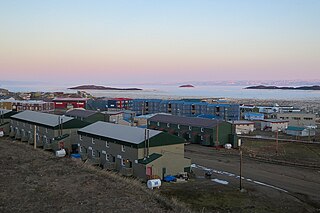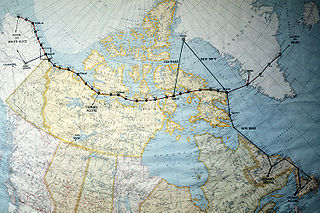
Iqaluit is the capital of the Canadian territory of Nunavut, its largest community, and its only city. It was known as Frobisher Bay from 1942 to 1987, after the large bay on the coast on which the city is situated. In 1987, its traditional Inuktitut name was restored.

Sir Martin Frobisher was an English seaman and privateer who made three voyages to the New World looking for the North-west Passage. He probably sighted Resolution Island near Labrador in north-eastern Canada, before entering Frobisher Bay and landing on present-day Baffin Island. On his second voyage, Frobisher found what he thought was gold ore and carried 200 tons of it home on three ships, where initial assaying determined it to be worth a profit of £5.20 per ton. Encouraged, Frobisher returned to Canada with an even larger fleet and dug several mines around Frobisher Bay. He carried 1,350 tons of the ore back to England, where, after years of smelting, it was realized that the ore was a worthless rock called hornblende. As an English privateer, he plundered riches from French ships. He was later knighted for his service in repelling the Spanish Armada in 1588.

Frobisher Bay is an inlet of the Davis Strait in the Qikiqtaaluk Region of Nunavut, Canada. It is located in the southeastern corner of Baffin Island. Its length is about 230 km (140 mi) and its width varies from about 40 km (25 mi) at its outlet into the Labrador Sea to roughly 20 km (12 mi) towards its inner end.

Nordair was a Quebec-based airline in Canada founded in 1947 from the merger of Boreal Airways and Mont Laurier Aviation.

Loks Land Island is part of the Arctic Archipelago in Nunavut, Canada. It is located off the eastern tip of Baffin Island's Blunt Peninsula, close to the mouth of Frobisher Bay. It has an area of 419 km2 (162 sq mi) and a coastline of 206 km. The local Inuktitut name for the island is Takuligjuaq.

Iqaluit Airport serves Iqaluit, Nunavut, Canada and is located adjacent to the city. It is operated by the government of Nunavut. It hosts scheduled passenger service from Ottawa, Montreal, Rankin Inlet, and Kuujjuaq on carriers such as Canadian North, and from smaller communities throughout eastern Nunavut. It is also used as a forward operating base by the Royal Canadian Air Force (RCAF). In 2011, the terminal handled more than 120,000 passengers.

Resolute Bay Airport is located at Resolute, Nunavut, Canada, and is operated by the government of Nunavut. It is one of the northernmost airfields in Canada to receive scheduled passenger airline service.
Events from the year 1578 in Ireland.
Augustus Island is one of the many uninhabited Canadian Arctic islands in the Qikiqtaaluk Region, Nunavut. It is a Baffin Island offshore island located in inner Frobisher Bay. The island lies at the head of Ward Inlet, between Becher Peninsula and Hall Peninsula. Bruce Island is located at the mouth of the inlet. Other islands in the immediate vicinity include Algerine Island, Frobisher's Farthest, McBride Island, and Pichit Island.

The 4733d Air Defense Group is a discontinued United States Air Force organization. Its last assignment was with the 64th Air Division at Frobisher Bay, Baffin Island, Northwest Territories, Canada, where it was discontinued in 1958. The group was formed in 1957 when ADC assumed responsibility for air defense of Northern Canada from Northeast Air Command, including support for remote Distant Early Warning Line radar sites. It also controlled two squadrons operating radars at dispersed locations. It was discontinued in 1958 and its DEW Line support mission transferred to the 4601st Support Group and its radar squadrons to the 4732d Air Defense Group in Newfoundland.
Gardiner Island is one of the many uninhabited Canadian arctic islands in Qikiqtaaluk Region, Nunavut. It is a Baffin Island offshore island located in Frobisher Bay south of the capital city of Iqaluit.
Coffin Island is one of the many uninhabited Canadian Arctic islands in the Qikiqtaaluk Region, Nunavut. It is a Baffin Island offshore island located in Frobisher Bay, southeast of the capital city of Iqaluit.
Crimmins Island is one of the many uninhabited Canadian Arctic islands in the Qikiqtaaluk Region, Nunavut. It is a Baffin Island offshore island located in Frobisher Bay, southeast of the capital city of Iqaluit.
Jenvey Island is one of the many uninhabited Canadian arctic islands in Qikiqtaaluk Region, Nunavut. It is a Baffin Island offshore island located in Frobisher Bay, southeast of the capital city of Iqaluit.
Pichit Island is one of the many uninhabited Canadian arctic islands in Qikiqtaaluk Region, Nunavut. It is a Baffin Island offshore island located in Frobisher Bay, approximately 4 km (2.5 mi) south of the capital city of Iqaluit. Other islands in the immediate vicinity include Crimmins Island, Frobisher's Farthest, Jenvey Island, Kudlago Island, and Sybil Island.
Alligator Island is one of the many uninhabited Canadian Arctic islands in the Qikiqtaaluk Region, Nunavut. It is a Baffin Island offshore island located in Frobisher Bay, southeast of the capital city of Iqaluit. Other islands in the immediate vicinity include Algerine Island, Camp Island, Culbertson Island, Frobisher's Farthest, Low Island, Mark Island, McAllister Island, McBride Island, Metela Island, Mitchell Island, Pan Island, Peak Island, Pink Lady Island, Precipice Island.
McBride Island is one of the many uninhabited Canadian arctic islands in Qikiqtaaluk Region, Nunavut. It is a Baffin Island offshore island located in Frobisher Bay, southeast of Iqaluit. Other islands in the immediate vicinity include Algerine Island, Alligator Island, Frobisher's Farthest, Mitchell Island, Pan Island, and Pink Lady Island.
Pink Lady Island is one of the many uninhabited Canadian arctic islands in Qikiqtaaluk Region, Nunavut. It is a Baffin Island offshore island located in Frobisher Bay, southeast of Iqaluit. Other islands in the immediate vicinity include Algerine Island, Alligator Island, Frobisher's Farthest, Low Island, and Mitchell Island.
Frobisher's Farthest is one of the many uninhabited Canadian arctic islands in Qikiqtaaluk Region, Nunavut. It is a Baffin Island offshore island located in Frobisher Bay, southeast of Iqaluit. It is 15 sq mi (39 km2) in size.

Kodlunarn Island, known as Qallunaaq in Inuktitut and originally named Countess of Warwick Island, is a small island located in Frobisher Bay in the Canadian territory of Nunavut. During the 1570s, explorer Martin Frobisher led expeditions to the island to mine what he believed was gold ore. The ore turned out to be worthless, and the island was ignored by explorers until Charles Francis Hall, inspired by oral history accounts from the Inuit of Frobisher Bay, visited the site in 1861 to investigate the remains of Frobisher's expeditions. Notable features of the island include two large mining trenches and the remains of a stone house built by Frobisher in 1578. Kodlunarn Island was designated a National Historic Site of Canada in 1964.









